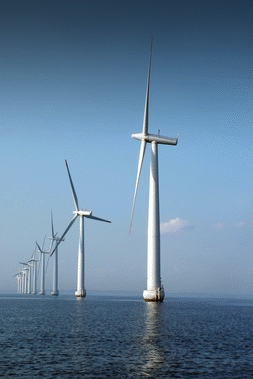Offshore Wind Energy Market in Germany: Current Situation, Project Development and Market Shares
- General conditions having an impact on the expansion of offshore wind energy in Germany
- Development of the additionally installed capacity of wind turbines in Germany
- Competitors participating in the market and their market shares
- The expert report analyzes the expansion of offshore wind energy in three scenarios with different premises.
The German Federal Maritime and Hydrographic Agency (BSH) has not approved any offshore wind project for one year. Numerous applications and the amended licensing law cause a further delay in the work process and raise uncertainty. In fact, there are more than thirty approvals for offshore wind farms in the German seas. But if the project developers or constructors do not respect the time scheduled for construction work, these approvals have to be returned to the BSH, theoretically starting in 2011.
At the moment, the vessel and port capacities and the logistic procedures allow an annual transshipment and the construction of only approximately 180 turbines.(Bremerhaven, Emden and partial supply from Esbjerg are taken into account. Cuxhaven serves “only” as port for foundation supply)
If the EEG (Germany’s Renewable Energy Sources Act) remuneration remains at the current level, the rate of additionally installed capacity will drop after the expiration of the early bird bonus. The UK remains Europe’s number one concerning the remuneration and funding of offshore wind energy.
Money is still a crucial factor for delays: The allocation of loans by the KfW (a promotional bank from Germany) has not taken place yet, so the financing of several projects will remain doubtful unless the allocation does not happen soon.
If there are no measures in order to accelerate the grid expansion, delays and capacity bottlenecks in the grid connection of wind farms and during the energy transfer into the country will be the case.
Scenario 1: “Statements of the project developers”
According to the project developers’ statements, this scenario illustrates the commissioning dates (unrealistic). The information received by the project developers is incomplete, that is why the total of the number of turbines/installed capacity is smaller than in other the scenarios. There are no commissioning dates for later points of time.
Scenario 2: “Targets of the Government”
This scenario will take place if the following prerequisites are met:
- The KfW loan program will soon be approved.
- The licensing procedures will be shortened/simplified.
- The grid connection and expansion will be realized quickly.
- The debate about the EEG amendment will be concluded in 2011 (compression model/prolongation of the early bird bonus).
- The necessary additional infrastructure will be constructed by 2014 (especially ports).
Scenario 3: “Further delays”
This scenario will take place if most of the prerequisites mentioned above are not met.